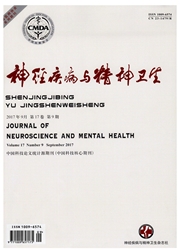

 中文摘要:
中文摘要:
目的探讨糖基化终末产物(AGEs)在β-淀粉样蛋白(Ap)产生中分子机制。方法以APPsw—N2a细胞为AD细胞模型,将细胞随机分为3组,空白对照组、AGEs组、AGEs+抗RAG抗体组。采用ELIsA方法检测各组Aβ40和Aβ42的表达水平,并用荧光检测法检测BACE1的活性。结果与对照组相比,AGEs组AD40、Aβ42表达水平及BACE1活性明显增加,差异有统计学意义(P〈0.01);预先用抗RAG中和抗体(1:100)1h后,A840,Aβ2表达水平及BACE1活性与AGEs组相比较明显减少,差异有统计学意义(P〈O.05)。结论AGEs可能通过上调BACEl的活性促使APPsw—N2a细胞A8生成增加,提示AGEs可能在AD发生、发展中起重要作用。
 英文摘要:
英文摘要:
Objective To investigate molecular mechanism of advanced glycation end products (AGEs) in the generation of β-amyloid protein(Aβ). Methods The APPsw--N2a cells were divided into three groups randomly(the control group, the AGEs graup, the AGEs+RAG group). To examine the ceils' growth state with MTT metabolic rate and determine the best concentration and time of the AGEs, and to observe the generation of Aβ by ELISA. Results Our data showed that APP was up-- reg-ulated by AGEs in vitro, and pretreatment of cells with an anti--RAG--antibody blocked the effects of AGEs. In conditioned medium, the level of Aβ increased after AGE treatment. Conclusions AGEs could promote the generation of Aβ by up--regulating the activities of BACE.
 同期刊论文项目
同期刊论文项目
 同项目期刊论文
同项目期刊论文
 Elevation of brain magnesium prevents and reverses cognitive deficits and synaptic loss in Alzheimer
Elevation of brain magnesium prevents and reverses cognitive deficits and synaptic loss in Alzheimer Xylocoside G reduces amyloid-β induced neurotoxicity by inhibiting NF-κB signaling pathway in neuron
Xylocoside G reduces amyloid-β induced neurotoxicity by inhibiting NF-κB signaling pathway in neuron Isoflurane anesthesia results in reversible ultrastructure and occludin tight junction protein expre
Isoflurane anesthesia results in reversible ultrastructure and occludin tight junction protein expre Impaired synaptic vesicle recycling contributes to presynaptic dysfunction in lipoprotein lipase-def
Impaired synaptic vesicle recycling contributes to presynaptic dysfunction in lipoprotein lipase-def Autophagy is involved in oral vaccination of anAAV/Aβ vaccine induced Aβ clearance in APP/PS1 transg
Autophagy is involved in oral vaccination of anAAV/Aβ vaccine induced Aβ clearance in APP/PS1 transg Inhalative formaldehyde exposure enhances aggressive behavior and disturbs monoamines in frontal cor
Inhalative formaldehyde exposure enhances aggressive behavior and disturbs monoamines in frontal cor Lipoprotein lipase deficiency leads to α-synuclein aggregation and ubiquitin C-terminal hydrolase L1
Lipoprotein lipase deficiency leads to α-synuclein aggregation and ubiquitin C-terminal hydrolase L1 Hypoxia-inducible factor-1α mediates up-regulation of neprilysin by histone deacetylase-1 under hypo
Hypoxia-inducible factor-1α mediates up-regulation of neprilysin by histone deacetylase-1 under hypo 期刊信息
期刊信息
